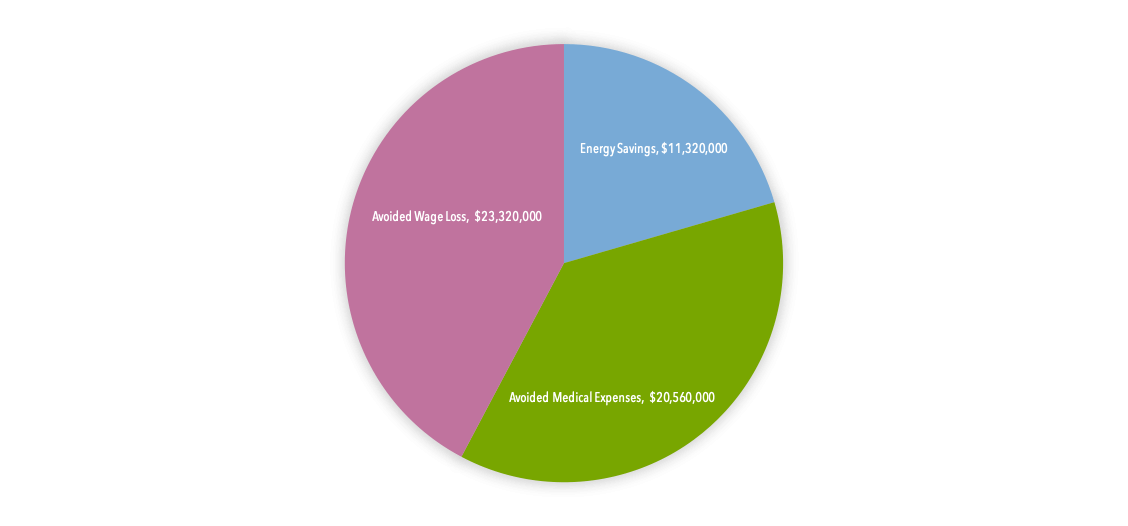In many cases, serious health and safety issues like mold, leaky roofs, asbestos, and general deterioration can prevent 15 percent of eligible homes from being weatherized. For example, in Philadelphia alone, 65 percent of low-income communities with high energy consumption experience significant home deterioration challenges, which prevent weatherization efforts. If homeowners or tenants are unable to address those underlying concerns, they are often unable to use WAP. To be able to maximize the value of the program for recipients, congress should consider further investment to expand the funding available to WAP and support necessary renovation to make homes weatherization-ready.
Building on the Success of the Clean Energy for Low Income Communities Accelerator (CELICA)
Achieving a 75 percent reduction in greenhouse gas emissions in the buildings sector would require cutting energy emissions from both homes and business. However, low-income households often lack the resources needed to cut their emissions by fully electrifying appliances or accommodating new renewable technologies. CELICA was created to specifically address the energy burden in low income communities by helping to support local renewable energy and energy efficiency programs.
CELICA was an accelerator program launched by DOE’s Better Buildings Program. Better Buildings Accelerators are temporary programs established to address specific obstacles to efficiency. Like WAP, CELICA focused on expanding energy efficiency in low-income households, but it also aimed to expand the installation of renewable sources of energy. In addition, CELICA created a toolkit to provide state and local program managers with the tools, resources, and models to allow them to establish energy efficiency and renewable energy programs in low- and moderate-income communities. Through partnerships between DOE and state and local governments, CELICA leveraged approximately $335 million in efficiency and renewable energy projects for 155,000 homes. The CELICA toolkit also provided approaches for decreasing the knowledge gap that often exists between DOE resources and state/local low-income energy-related programs. The “Stakeholder Engagement” section in the toolkit outlines strategies and a template for state and local programs to work with stakeholders to ensure the efficacy of energy efficiency and renewable energy programs.
CELICA created a template for partnerships with DOE to be able to advance the implementation of renewables technologies. For example, in Tennessee, the non-profit organization GreenSpaces was able to provide energy efficiency supplies and education to low-income communities which resulted in an average of 15 percent reduction in energy costs for participants. Additionally, in Washington, D.C., the Solar for All Innovation and Expansion program is looking to install 240 to 300 megawatts of solar power, which would reduce approximately 119 to 149 metric tons of CO2 emissions over 15 years. CELICA also helped create a partnership between Colorado Energy Office and the utility company Xcel Energy to increase access to clean, affordable energy, including 18 megawatts of new low-income community solar power.
Information about beneficial DOE programs may not reach many marginalized communities, restricting their access to programs advancing energy efficiency and renewable energy projects. CELICA provided a foundation for closing this knowledge gap by providing state and local government strategies for stakeholder engagement, as well as tools and templates that assess community barriers and help move projects ahead. It will be important for the federal government to learn and build from the success of CELICA when moving forward future programs.
Moving Forward with Recovery and Resilience
The longer it takes to reinvigorate the economies in these communities, the more vulnerable they will become to future extreme weather and other climate-related impacts. Programs like CELICA and WAP have helped support job creation and should be used to stimulate the economy and support low-income communities that have been hit hardest by the pandemic. Any economic recovery-related legislation should prioritize expanding funding for existing programs like WAP and future efforts like CELICA to ensure that these communities are more sustainable and resilient, not only to climate-related hazards but also to future economic and public health challenges.

